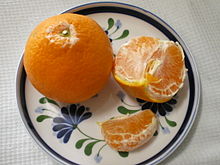| Kiyomi | |
|---|---|
 Kiyomi | |
| Genus | Citrus |
| Hybrid parentage | C. unshiu × sinensis |
| Origin | Japan |
Kiyomi (清見, kiyomi) ( Citrus unshiu × sinensis) is a Japanese citrus fruit that is a hybrid of a Miyagawa Wase mikan and an orange. [1] The new breed was the first tangor created in Japan in 1949. It was named Kiyomi after the temple Seiken-ji (清見寺) and the lagoon Kiyomi-gata (清見潟) near its experiment station in Shizuoka city and registered as "Tangor Nōrin No.1" [2] in 1979. [3]
Kiyomi are sweet. Sugar content is normally 11–12 ° Bx and reaches even 13 °Bx if conditions are met. Citric acid content is around 1%. It has no seeds. The time of ripening is mid to late March. [3] The flavor is similar to that of a mikan, while the aroma is similar to that of an orange.[ citation needed]
Kiyomi is a monogerm, so it is often used as a parent citrus to create new hybrids such as dekopon.[ citation needed]
References
- ^ "Trovita sweet orange". University of California Riverside. Archived from the original on 2010-07-01. Retrieved 2010-03-22.
- ^ Tangor agricultural and forestry No.1 (タンゴール農林1号)
- ^ a b Nishiura, Masao; et al. (1983). "Kiyomi: A new variety of citrus" (PDF). Bulletin of Fruit Tree Research Station B (in Japanese) (10:1–9). Ministry of Agriculture and Forestry Japan.
External links
- Kiyomi at the National Agriculture and Food Research Organization (in Japanese)
| Kiyomi | |
|---|---|
 Kiyomi | |
| Genus | Citrus |
| Hybrid parentage | C. unshiu × sinensis |
| Origin | Japan |
Kiyomi (清見, kiyomi) ( Citrus unshiu × sinensis) is a Japanese citrus fruit that is a hybrid of a Miyagawa Wase mikan and an orange. [1] The new breed was the first tangor created in Japan in 1949. It was named Kiyomi after the temple Seiken-ji (清見寺) and the lagoon Kiyomi-gata (清見潟) near its experiment station in Shizuoka city and registered as "Tangor Nōrin No.1" [2] in 1979. [3]
Kiyomi are sweet. Sugar content is normally 11–12 ° Bx and reaches even 13 °Bx if conditions are met. Citric acid content is around 1%. It has no seeds. The time of ripening is mid to late March. [3] The flavor is similar to that of a mikan, while the aroma is similar to that of an orange.[ citation needed]
Kiyomi is a monogerm, so it is often used as a parent citrus to create new hybrids such as dekopon.[ citation needed]
References
- ^ "Trovita sweet orange". University of California Riverside. Archived from the original on 2010-07-01. Retrieved 2010-03-22.
- ^ Tangor agricultural and forestry No.1 (タンゴール農林1号)
- ^ a b Nishiura, Masao; et al. (1983). "Kiyomi: A new variety of citrus" (PDF). Bulletin of Fruit Tree Research Station B (in Japanese) (10:1–9). Ministry of Agriculture and Forestry Japan.
External links
- Kiyomi at the National Agriculture and Food Research Organization (in Japanese)